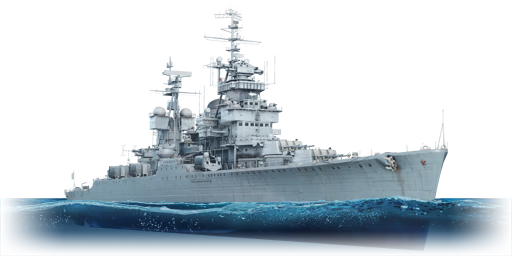The Mikhail Kutuzov was a Sverdlov-class light cruiser, the last conventional gun cruisers built for the Soviet Navy. They were modified and enlarged versions of the Project 68-K Chapayev-class light cruisers. Unlike the Chapayev class, the Sverdlov class were built with two quintuple 533 mm torpedo launchers on each side of the hull, with two spare torpedoes for each launcher. The anti-aircraft armament was also strengthened as the Sverdlov class gained two additional pairs of 100 mm twin turrets as well as two 37 mm twin V-11 autocannon turrets. Despite their size and displacement, the maximum speed was an impressive 32.5 kn (60.2 km/h). Named after Mikhail Kutuzov, a Field Marshal of the Russian Empire that defeated Napoleon during his campaign to Russia, she was laid down on 23rd February 1951, commissioned on 30th December 1954, and assigned to the Black Sea Fleet of the Soviet Navy. In 1955, she became a test platform for the first naval helicopters, namely the Mi-1 and Ka-15. When on 29th October 1955, ex-Italian battleship Guilio Cesare, now Novorossiysk, exploded while at anchor at Sevastopol, Mikhail Kutuzov was the closest ship moored to the battleship. She immediately sent rescue teams to help and 27 of her sailors died during the rescue effort. In 1961, Yuri Gagarin, the first human in space visited the ship. In 1986, Mikhail Kutuzov became the last Sverdlov-class cruiser to undergo refit to Project 68-A standard which included removing all of her torpedo tubes and four twin 37 mm cannon mounts, and replacing them with 30 mm AK-230 CIWS mounts as well as changing her radar and ECM suite to the latest standard. She was transferred into reserve in 1987 and decommissioned on 3rd June 1992. Stricken from inventory in 2000 and on 28th July 2002 she became a museum ship permanently moored in Novorossiysk.
Mikhail Kutuzov was introduced in Update "Drone Age". Her armour protection is a significant improvement over the previous Project 26 class, which the Project 68 and 68-K and 68-A design comes from, as well as having guns with higher rate of fire, although at cost of penetration characteristic. Her anti-aircraft protection suite was expanded with thirty-two 37 mm automatic V-11 cannon barrels as well as twelve 100 mm dual purpose guns and eight twin 30 mm AK-230 CIWS mounts as she is depicted after her Project 68-A refit from 1986. The anti-air capability is further enhanced by a search and track radar with range of up to 150 km. Just like Chapayev, her magazines are close to waterline being more vulnerable to being hit, leading to fatal explosion.














